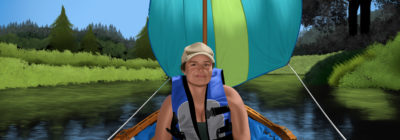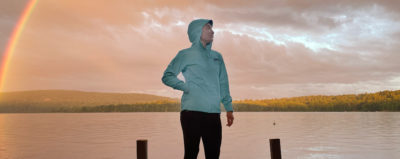James Baker, his wife, and their two young daughters live aboard LIVELY, a 42′ wooden gaffer that James built in the traditional manner of a turn-of-the-20th-century Cornish workboat and launched in 2015. For a four-month cruise around Ireland and along the west coast of Scotland, planned for the spring of 2019, James thought a single tender wouldn’t give his family and the occasional crew members the flexibility needed for the anchorages they’d visit. There was space on board LIVELY for a second tender 8′ long with a beam of 3′. Whatever was to occupy the space had to be in keeping with the look and feel of the gaffer.While James and his family live in Penryn on England’s South West Peninsula, he has long been attracted to the curraghs of Ireland. James had built a few skin-on-frame boats—a Geodesic Snowshoe 14 and Kudzu Craft Curlew kayak—and their quick and inexpensive construction was just what the tight timetable and budget of the fast-approaching cruise demanded.The most common curraghs are about 20′ long and are rowed by a crew of three, but on Ireland’s northwest coast, County Donegal’s paddling curraghs bridge the gap in size between curraghs and coracles. Their bows are nearly round, like half of a coracle, and the rest of the hull extends to a transom typical of curraghs. They have a length of about 8′, right on target for the space on LIVELY. The Donegal curraghs are usually propelled by a paddler kneeling in the bow and using a single-bladed paddle, but since the middle of the last century, some have been equipped with tholepins for rowing.
Join The Conversation
We welcome your comments about this article. To include a photo with your remarks, click Choose File below the Comment box.













I think airplane dope, which is what I used on a skin-on-frame kayak in 1962, works very well for many years. This was very tight and strong construction. After pulling the heavy duck canvas onto the bottom framing to the top of the sheer line, we tacked the canvas to the framing, tight. We then applied airplane dope, what they called it in the day, over the decked double-paddle canoe. We then put on a double bottom to the water line from the keel.We then did the same procedure on the top side as well. The whole job was done by myself and my good friend. We were 12 years old at the time and had no help from anybody! We had a lot of fun and it didn’t leak a drop!!!!
Aircraft dope on canvas was the common treatment for skin-on-frame kayaks and canoe when I started building in the mid ’70s. It dries quickly (giving off tremendous amounts of solvent vapor) so there is very little drying time between coats.I started with a thinned coat of clear dope and followed up with undiluted clear with aluminum powder mixed in (for UV protection) and finished with white dope. I didn’t put any treatment on the inside surface of the canvas and that left it susceptible to mildew and, eventually, rot. Then it was time for a new skin.
I switched to ballistic nylon and two-part urethane, a combination that is much tougher and longer lasting.
For my coracle I went back to canvas for a covering, and with some guidance from James, used a roofing tar similar to what he used on DREADNOUGHT. I rather like the look and feel of it.
Very young children and NO PFDs?
Just out of curiosity: Could the polyester have been shrunk tight with a heat gun? I think this is possible with ballistic nylon. George Dyson does this with his skin-on-frame baidarkas. (George is son of the astrophysicist Freeman Dyson, and one of the main individuals in “The Starship and the Canoe.” Freeman had a scheme in mind for propelling space ships, and George specialized in Aleut kayaks, their construction, and their history. Don’t recall the author’s name.)
Kenneth Brower wrote The Starship and the Canoe. Good book.
—Ed.